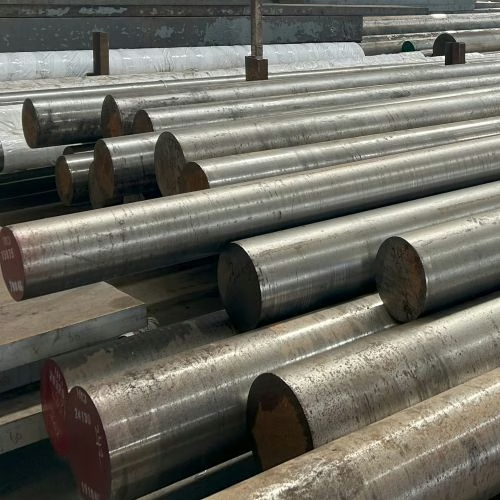5CrW2Si Tool Steel: Technical Specifications and Applications
At Aobo Steel, with our extensive experience in forging tool steel for over 20 years, we understand the importance of precise material selection. Here’s a straightforward look at 5CrW2Si tool steel, a versatile alloy tool steel known for its toughness.

1. 5CrW2Si tool steel Chemical Composition (GB/T 1299-2000)
Understanding the exact chemistry is crucial. According to the GB/T 1299-2000 standard, the composition of 5CrW2Si steel is:
- Carbon (C): 0.45% – 0.55%
- Silicon (Si): 0.50% – 0.80%
- Manganese (Mn): max0.40%
- Chromium (Cr): 1.00% – 1.30%
- Tungsten (W): 2.00% – 2.50%
- Phosphorus (P): max0.030%
- Sulfur (S): max0.030%
Note: International standards may differ slightly. Specifying the required standard for your application is essential.
2. Comparison with International Standards
For reference, here are compositions for comparable grades under other standards:
- EN ISO 4957:2001 (50WCrV8): C 0.45-0.55%, Cr 1.70-2.20%, W 0.70-1.10%, V 0.15-0.45%
- JIS G4404:2006 (SKS4): C 0.45-0.55%, Cr 0.50-1.00%, W 0.50-1.00%
- ГОСТ 5950-2000 (5ХВ2С / 5XB2C): C 0.45-0.55%, Cr 0.90-1.20%, W 1.80-2.30%, Si 0.80-1.10%, Mn 0.15-0.45%, V 0.15-0.30%
3. 5CrW2Si tool steel Key Physical Properties
Understanding these properties is vital for heat treatment planning:
3.1 Critical Temperatures (Approximate)
- Ac1: 775∘C
- Ac3: 860∘C
- Ar1: 775∘C
- Ms (Martensite start): 295∘C
3.2 Linear Expansion Coefficients (Approximate)
- 100−250∘C: 13.15×10−6/∘C
- 250−350∘C: 13.6×10−6/∘C
- 350−600∘C: 13.8×10−6/∘C
- 600−700∘C: 14.2×10−6/∘C
4. 5CrW2Si tool steel Heat Treatment Procedures
Correct heat treatment is fundamental to achieving the desired performance from 5CrW2Si. Our experience guides these common practices:
4.1 Preparatory Heat Treatment (Annealing)
- Ordinary Annealing: Heat to 800−820∘C, hold 3-5 hrs, furnace cool (≤30∘C/hr) to 600−650∘C, then air cool. Target hardness: ≤229 HBW. Microstructure: Granular pearlite, small carbides.
- Isothermal Annealing: Heat to 830−840∘C, hold 2-3 hrs, furnace cool to 680−700∘C, hold 3-4 hrs, furnace cool to 500∘C, then air cool. Target hardness: ≤229 HBW.
- High-Temperature Tempering (Post-Forging): Heat to 710−740∘C, hold 3-6 hrs, furnace or air cool. Improves machinability. Hardness: 207-255 HBW. Microstructure: Granular pearlite, small carbides.
4.2 Hardening (Quenching)
- Quenching Temperature: 860−900∘C.
- Quenching Medium: Oil (20−40∘C). Cool until the part reaches oil temperature.
- Post-Quench Hardness: ≥55 HRC.
4.3Tempering
Tempering adjusts hardness and improves toughness:
- Stress Relief/Stabilization: Temper at 200−250∘C (oil or molten alkali). Air cool. Hardness: 53-58 HRC.
- Hardness Reduction/Stress Relief: Temper at 430−470∘C (air furnace or molten alkali/nitrate). Air cool. Hardness: 45-50 HRC.
Hardness vs. Tempering Temperature (Approximate, after 880°C Oil Quench):
- 100∘C: ~55 HRC
- 200∘C: ~53.5 HRC
- 300∘C: ~51 HRC
- 400∘C: ~47 HRC
- 500∘C: ~41 HRC
- 600∘C: ~33 HRC
5. Mechanical Properties and Characteristics
- Toughness: Good toughness after tempering, aided by Tungsten (W) refining grain size.
- Overall Properties: Exhibits good comprehensive mechanical properties.
- Hardenability: Relatively low carbon content means hardenability isn’t extremely high, but surface hardness can be increased via carburizing.
- Temper Brittleness: Slight risk in the 300−350∘C tempering range. Tempering around 250∘C (54-56 HRC) or 450∘C (50-52 HRC) offers good balances of hardness and toughness.
- Considerations: It is sensitive to decarburization during heating. Quenching deformation requires careful control. Wear resistance under abrasion and impact toughness are lower than those of some specialized Mo-Ni steels.
6. Common Applications
5CrW2Si is suitable for tools and dies facing impact and wear:
- Manual and pneumatic chisels, air hammer tools, rivet tools
- Cold punching dies, shear blades (cold cutting), blanking/trimming dies
- Heavy-duty cold heading punches
- Medium-load steel plate piercing punches
- Precision dies
- Woodworking tools
- Cutters for threading dies
- Hot work applications: Punching/piercing tools, shear dies, hot forging dies, die-casting molds (fusible alloys)
- Large/medium heavy-duty round scissors and long shear blades
7. Comparison with Similar Grades
- vs. 4CrW2Si: Similar performance. 5CrW2Si generally offers slightly better hardenability and high-temperature strength.
- vs. 6CrW2Si: 5CrW2Si has better toughness but slightly lower temper resistance and wear resistance. 6CrW2Si is often chosen when wear/collapse are primary failure modes.
8. Equivalent Steel Grades
For international reference:
- ISO: 50WCrV8
- EN: 50WCrV8
- JIS (Japan): SKS4
- ГОСТ (Russia): 5ХВ2С (5XB2C)
- ASTM/UNS (USA): T41901
- DIN (Germany): 45WCrV7
Explore Our Other Products
D2/1.2379/SKD11
D3/1.2080/SKD1
D6/1.2436/SKD2
A2/1.23663/SKD12
O1/1.2510/SKS3
O2/1.2842
S1/1.2550
S7/1.2355
DC53
H13/1.2344/SKD61
H11/1.2343/SKD6
H21/1.2581/SKD7
L6/1.2714/SKT4
M2/1.3343/SKH51
M35/1.3243/SKH55
M42/1.3247/SKH59
P20/1.2311
P20+Ni/1.2738
420/1.2083/2Cr13
422 stainless steel
52100 bearing steel
440C stainless steel
4140/42CrMo4/SCM440
4340/34CrNiMo6/1.6582
4130
5140/42Cr4/SCR440
SCM415
✅ Get a Free Quote + Expert Metallurgical Support – Only from Aobo Steel
Looking for 5CrW2Si tool steel?
We supply high-quality 5CrW2Si with full chemical and mechanical property certifications.
🔹 MOQ from just 100kg – ideal for trial or urgent projects
🔹 Fast delivery – stocked sizes & custom cutting available
🔹 Free metallurgical consultation – ask our experts before you buy
🔹 Mill Test Certificate (MTC) included with every order
